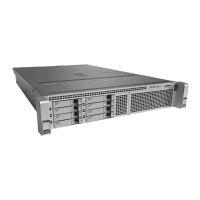NIC Redundancy
• None—Redundancy is not available.
• Active-Active—All Ethernet ports operate simultaneously. This mode provides multiple paths to the
CIMC.
• Active-Standby—One port fails over to the other.
The available redundancy modes vary depending on the selected network mode and your platform. For the
available modes, see the Installation and Service Guide for your platform.
Configuring Server NICs
Configure a server NIC when you want to set the NIC mode and NIC redundancy.
Before You Begin
You must log in as a user with admin privileges to configure the NIC.
Procedure
Step 1
In the Navigation pane, click the Admin tab.
Step 2
On the Admin tab, click Network.
Step 3
In the Network pane, click the Network Settings tab.
Step 4
In the NIC Properties area, update the following properties:
DescriptionName
The NIC mode. This can be:NIC Mode drop-down list
• Dedicated—The management port is used to access the CIMC.
• Shared LOM—The LOM (LAN On Motherboard) ports are used
to access the CIMC.
• Shipping—The out-of-the-box defaults will be used for all options.
This option is only available for some C-Series
servers.
Note
The NIC redundancy options depend on the mode chosen in the NIC
Mode drop-down list. If you do not see a particular option, then it is
not available for the selected mode.
NIC Redundancy drop-down list
The available options are:
• None—Each port associated with the configured NIC mode
operates independently. The ports do not failover if there is a
problem.
• active-active—If supported, all ports associated with the
configured NIC mode operate simultaneously. This increases
throughput and provides multiple paths to the CIMC.
Cisco UCS C-Series Servers Integrated Management Controller GUI Configuration Guide, Release 1.1(2)
42 OL-22894-01
Configuring Server NICs
Server NIC Configuration

